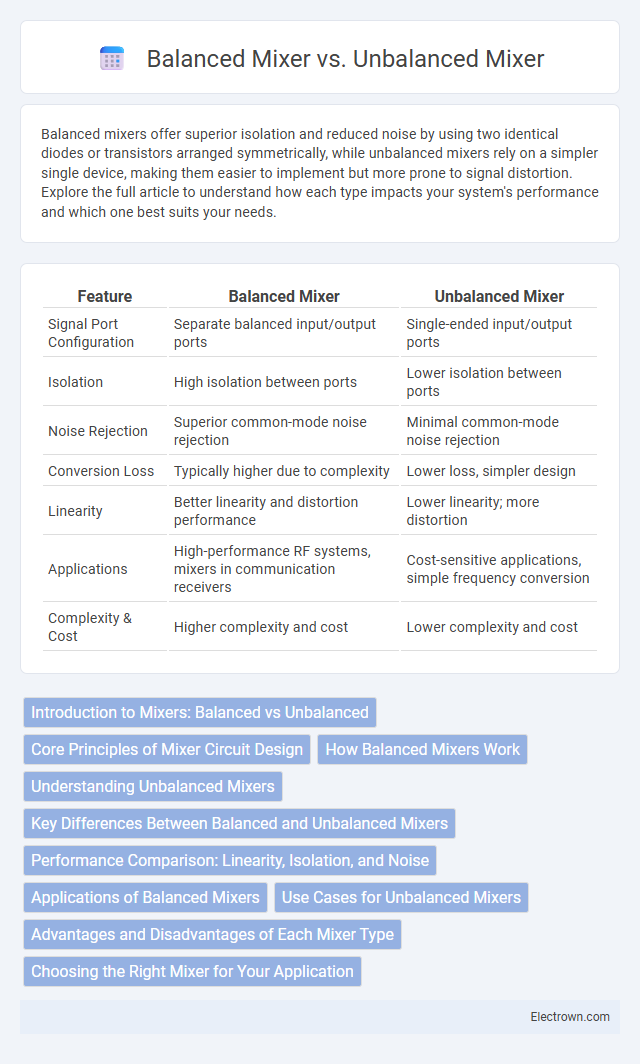Balanced mixers offer superior isolation and reduced noise by using two identical diodes or transistors arranged symmetrically, while unbalanced mixers rely on a simpler single device, making them easier to implement but more prone to signal distortion. Explore the full article to understand how each type impacts your system's performance and which one best suits your needs.
Table of Comparison
| Feature | Balanced Mixer | Unbalanced Mixer |
|---|---|---|
| Signal Port Configuration | Separate balanced input/output ports | Single-ended input/output ports |
| Isolation | High isolation between ports | Lower isolation between ports |
| Noise Rejection | Superior common-mode noise rejection | Minimal common-mode noise rejection |
| Conversion Loss | Typically higher due to complexity | Lower loss, simpler design |
| Linearity | Better linearity and distortion performance | Lower linearity; more distortion |
| Applications | High-performance RF systems, mixers in communication receivers | Cost-sensitive applications, simple frequency conversion |
| Complexity & Cost | Higher complexity and cost | Lower complexity and cost |
Introduction to Mixers: Balanced vs Unbalanced
Balanced mixers employ two signal paths with equal and opposite phases to cancel noise and enhance signal integrity, making them ideal for high-frequency and RF applications. Unbalanced mixers use a single-ended signal path, simplifying design but increasing susceptibility to noise and signal distortion. The choice between balanced and unbalanced mixers depends on factors such as linearity, isolation, and complexity requirements in communication and signal processing systems.
Core Principles of Mixer Circuit Design
Balanced mixers use two diodes or transistors arranged in a symmetrical configuration to cancel out unwanted signals and reduce local oscillator feedthrough, improving signal isolation and linearity. Unbalanced mixers employ a single nonlinear device, resulting in simpler design but higher levels of spurious signals and lower isolation between ports. Core principles in mixer circuit design emphasize linearity, isolation, conversion efficiency, and suppression of undesired mixing products to enhance overall RF system performance.
How Balanced Mixers Work
Balanced mixers operate by utilizing two or more signal paths with matched impedances to suppress unwanted noise and local oscillator (LO) feedthrough, ensuring cleaner signal conversion. The design typically involves using two diodes or transistors arranged symmetrically, which cancel out even-order harmonics and reduce intermodulation distortion. This symmetrical operation enhances isolation between ports, making balanced mixers ideal for high-performance RF and microwave frequency conversion applications.
Understanding Unbalanced Mixers
Unbalanced mixers feature a single input signal combined with a local oscillator, making them simpler and less costly but more prone to noise and spurious signals. These mixers typically use diode or transistor configurations and are common in applications where high isolation and linearity are less critical. Understanding unbalanced mixers helps in evaluating their suitability for receivers and transmission systems with moderate performance requirements.
Key Differences Between Balanced and Unbalanced Mixers
Balanced mixers use two signals with equal amplitude but opposite phase to cancel out noise and improve signal clarity, while unbalanced mixers rely on a single signal path that is more prone to interference. Balanced mixers typically offer better performance in professional audio and RF applications by minimizing distortion and electromagnetic interference. Your choice depends on the required noise rejection and signal integrity for the specific application.
Performance Comparison: Linearity, Isolation, and Noise
Balanced mixers offer superior linearity and isolation compared to unbalanced mixers, significantly reducing unwanted signal interference and distortion in RF applications. The inherent design of balanced mixers cancels even-order harmonics and provides better port-to-port isolation, enhancing overall system performance and minimizing noise figure. In contrast, unbalanced mixers typically exhibit higher noise levels and poorer isolation, making them less suitable for high-performance or sensitive communication systems.
Applications of Balanced Mixers
Balanced mixers are widely used in communication systems, radar technology, and signal processing applications due to their superior performance in suppressing local oscillator feedthrough and even-order harmonics, which enhances signal clarity and reduces noise. They are preferred in high-frequency and microwave circuits where maintaining signal integrity and minimizing interference are crucial, such as in satellite receivers and RF transceivers. The ability to provide isolation between input ports makes balanced mixers essential in sensitive measurement equipment and advanced wireless communication devices.
Use Cases for Unbalanced Mixers
Unbalanced mixers are commonly used in applications where simplicity and cost-effectiveness are priorities, such as in consumer audio equipment and basic RF signal processing. Their design allows for easier implementation in low-frequency or single-ended systems, making them ideal for radio receivers and transmitters where isolation between ports is less critical. Your choice of an unbalanced mixer may benefit scenarios requiring straightforward frequency conversion without the added complexity of balanced circuitry.
Advantages and Disadvantages of Each Mixer Type
Balanced mixers offer superior isolation between ports, minimizing local oscillator feedthrough and providing better suppression of even-order harmonics, which enhances signal clarity in communication systems. Unbalanced mixers are simpler in design and typically less expensive, but they suffer from higher local oscillator leakage and poorer isolation, potentially causing interference in sensitive RF applications. Your choice depends on system requirements where balanced mixers excel in performance-critical scenarios while unbalanced mixers are suitable for cost-conscious, less demanding applications.
Choosing the Right Mixer for Your Application
Selecting the right mixer involves understanding the key differences between balanced and unbalanced mixers; balanced mixers offer superior noise rejection and isolation, making them ideal for high-frequency and precision applications. Unbalanced mixers are simpler, cost-effective, and suitable for low-frequency or less critical environments where signal interference is minimal. Evaluating factors such as signal integrity, isolation requirements, and application environment ensures optimal mixer performance and system reliability.
Balanced Mixer vs Unbalanced Mixer Infographic

 electrown.com
electrown.com